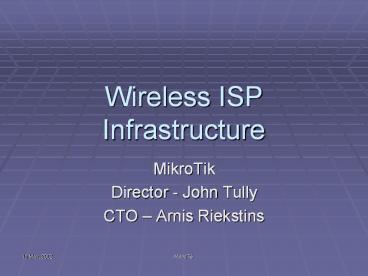Wireless ISP Infrastructure - PowerPoint PPT Presentation
1 / 22
Title:
Wireless ISP Infrastructure
Description:
DSL connection from Telco. Lease line from Telco using v.35 HDLC or E1 ... networks may be shaped and charged according to speed ... bandwidth test when ... – PowerPoint PPT presentation
Number of Views:311
Avg rating:3.0/5.0
Title: Wireless ISP Infrastructure
1
Wireless ISP Infrastructure
- MikroTik
- Director - John Tully
- CTO Arnis Riekstins
2
AP Platform
- multiple radios per AP
- Increase aggregate bandwidth using
non-overlapping frequencies - Re-use of network configurations such as
firewalls and users - Network services closest to the user (PPPoE,
DHCP, and PPTP)
3
From AP directly to client(no router on client
site)
- AP MAC registration table
- Assign IP to MAC with ARP disabled
- Restricted MAC level forwarding on wireless
network
4
(cont) AP direct to client
- PPPoE access concentrator
- Overview
- AC configuration demonstration
- Window XP client configuration demonstration
- Encryption MPPE protocol, advantages in
wireless - Radius authentication
- no engineer needed for account changes
- automatic billing with legacy systems
5
(cont) AP direct to client
- Bandwidth setting
- Tx and rx settings allow you to simulate DSL
offers - Address assignment
6
(cont) AP direct to client
- PPTP
- DHCP assigns private IP address
- PPTP on Windows
- PPTP clients available back to Windows 3.11
- Radius authentication
- Scripting to set bandwidth (in v2.6)
- Demonstration of setup, server and client
7
From Wireless Client Router to Client LAN
- General description of client site router
- Protects wireless network from hacking by
customers - Offer services to customers
- Masqueraded address
- Static NAT for servers
8
From Wireless Client Router to Client LAN (cont)
- Multiple client connected to same router
- Per interface firewall
- Multiple ethernet interfaces in client site
router - Using a smart switch with router and VLAN tags on
a port basis (v2.6) - Using an ethernet bridge and PPPoE or PPTP
9
From Wireless Client Router to Client LAN (cont)
- MikroTik Packet Packer Protocol (M3P)
- Wireless has high per packet overhead
- Negotiating access to wireless medium
- Acknowledgment and error correction
- M3P packs small packets into a large wireless MAC
packet and increase throughput up to four times
(with 100 byte packets) - Automatically discovers other MikroTik routers
with this feature enabled
10
From Wireless Client Router to Client LAN (cont)
- Services to customers beyond an IP gateway
- DHCP
- Special firewall configurations
- Per IP address accounting (even on masqueraded
addresses) - Dedicated VPN tunnel between other offices
- LAN bridge between other offices
11
From AP to the backbone
- Backup Links / Failover
- OSPF
- Tunnels over non-OSPF networks to OSPF backbone
networks - Increasing throughput
- Aggregation of Interfaces multi-path routing
- PPTP tunnel compression
12
From AP to the backbone (cont)
- Types of backbone connections
- additional point to point wireless 2.4GHz
interfaces using non-overlapping frequency or
5.8GHz - licensed frequency microwave systems
- DSL connection from Telco
- Lease line from Telco using v.35 HDLC or E1/T1
interface in AP - Use of HomePNA 14Mb/s interface up to 1.3km with
one twisted pair - Use of SDSL up to 2.3Mb/s and 5km (speed
decreases with distance)
13
Bandwith shaping
- problems when there is no shaping
- users get high speed local services on a "luck"
basis - high paying users may get low quality service
when bandwidth is not managed - backbones to wireless may get overloaded
- basic description of queues and function
- where to put queues
14
Bandwith shaping (cont)
- simple queue and complex queue configuration
- boss at client site wants better quality for
himself - webserver and mail server may be specifically
shaped based on usage - varied IP subnets may be put into one group with
a certain allocation
15
Bandwith shaping (cont)
- scripting may be used to change the bandwidth
speed settings - for a day speed and night speed
- tunnels linking enterprise networks may be shaped
and charged according to speed - for example, a VPN tunnel with ethernet bridging
between a company warehouse LAN and main office
LAN
16
Bandwith shaping (cont)
- DEMO CONFIGURATION AREA ON ROUTER FOR SHAPING
17
Interference and antenna co-location
- 2.4GHz frequencies (three non-overlapping)
- omni versus sectoral
- building top antenna co-location
- plan with barriers between antenna that have an
overlapping frequency - example, concrete structure such as elevator gear
box houses - mount on sides of building one floor or more
below roof top so that there is concrete
separating the antennas
18
Interference and antenna co-location (cont)
- 2.4GHz frequencies (three non-overlapping)
- omni versus sectoral
- Reflections (plus and minus)
- Signal may be reflected off another object to
make a connection when there is no line of sight - Reflections may cause a direct signal to be
cancelled
19
Interference and antenna co-location (cont)
- Interference may be mistaken for cabling problems
- Cable is too long (10m or less is suggested for
client site though locations close (less than
2km) to the AP may have very long cable - Water may have gotten into the strands of the
cable (cable must be replaced)
20
Interference and antenna co-location (cont)
- Grounding may be incorrect (if you see small
sparks when connecting cables) - Radio cable may be located to some high voltage
lines that can cause interference
21
Interference and antenna co-location (cont)
- change polarity of overlapping frequency antennas
for a 20dB drop - bandwidth test when installing antennas
- small movements of the mount location may make
giant differences - using antenna diversity
- radio power and amplifiers
22
Sample system design
- Situation proposed by audience































